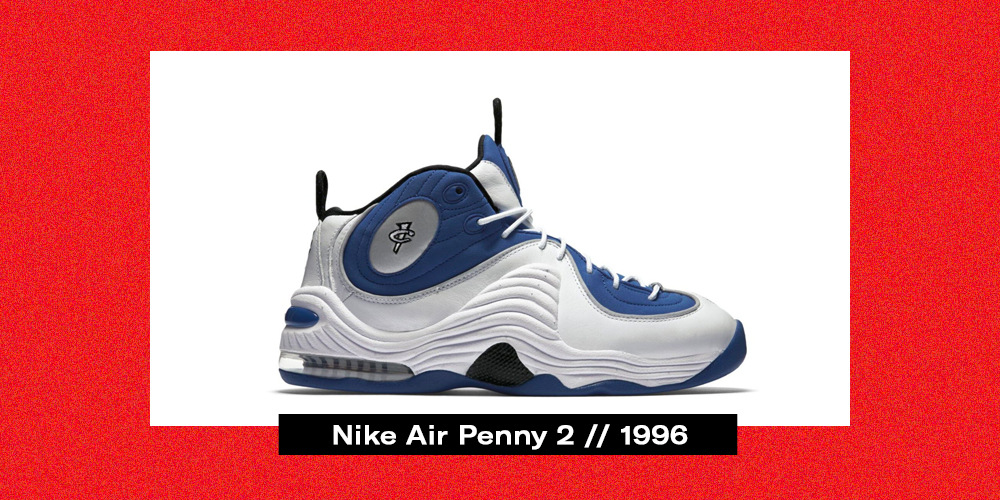Presented by
Having your own signature shoe? A rite of passage. Getting a second signature shoe? You’ve officially arrived.
Such is true for reigning MVP and Nike unicorn Giannis Antetokounmpo. Coming into the bubble, his newly unveiled Nike Zoom Freak 2 is the hottest model in the NBA and available now. Designed for an international superstar at peak popularity, the stakes are high for Giannis’ second silo.
Like a sophomore album, the pressure to top your debut is intense on a signature sequel. Not only is the brand looking to showcase personality and growth on the updated design, the athlete has to perform and the shoe has to sell. This phenomenon is nothing new, however. The pressure to come in hot the second time around has daunted designers and hoopers for decades.
Historically, signature sequels are known to be some of the most important, polarizing plays in footwear. Peter Moore and Bruce Kilgore headed to Italy to make Mike’s followup to the AJ1, Aztec inspiration pushed the narrative for Kobe exiting Adidas, and timing took Grant Hill and Steph Curry to the top.
So, how will Giannis and his red-hot Freak 2 fare in the rich history of second signatures? Study the tale of the tape below to find out.
Air Jordan 2 // 1986
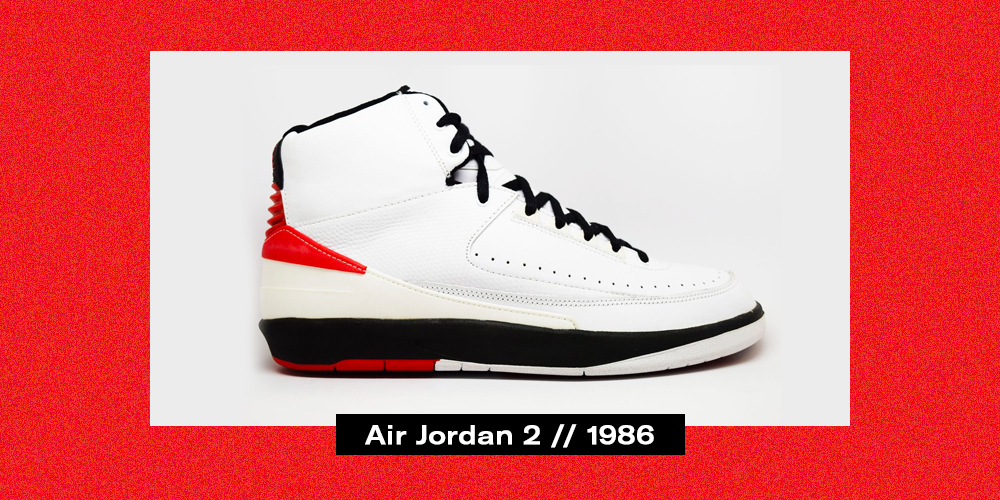
Imagine Jayson Tatum or Ja Morant balling out in the bubble in a pair of Balenciaga Arenas or Maison Martin Margiela Futures.
Essentially, that’s what Michael Jordan did entering the 1986-87 season with the Air Jordan 2.
In the pantheon of sneaker hysteria, the Air Jordan 2 may register as boring compared to its predecessor and successors. In actuality, it was perhaps the riskiest model the Beaverton brand ever designed.
Ditching Nike’s famed sidewall Swoosh and heading to Italy for production, the “high fashion” AJ2 was a far deviation from that of the bold Air Jordan 1. Faux lizard panelling and Made in Italy hang tags all played to prestige with an $100 price tag echoing that stance. With the original Air Jordan 1 retailing at $65, the price hike, presentation and place of production were all decidedly different from that of the origin.
From a tooling standpoint, the AJ2 was technically advanced. Becoming the breadwinner, the Air Jordan 2 would catapult Mike’s flagship line to setting new standards for Nike Basketball’s application of innovation. For starters, the use of TPU support on the heel counter and eyelets was a drastic departure from that of the strictly leather AJ1. In that same season, adding plastic reinforcements to the upper would soon become an industry standard for not only Nike on models like the Air Force 2, but soon by Spot-Bilt and adidas who would use similar TPU tactics on their signature sneakers for the likes of Xavier McDaniel and Patrick Ewing. Under the upper, designer Peter Moore would bring on Bruce Kilgore for an enhanced Air sole, styled to be softer and more supportive after MJ’s infamous foot injury the season before.
For the player David Falk intended to sell like a tennis player, such status was realized on the Air Jordan 2. A risk at retail and blatantly unbranded, the Air Jordan 2 proved to push the envelope for Nike on how much they could market Mike individually and how risky they could get in regard to tech and pricing.
Such standards would be realized one year later by the Air Jordan 3. The rest as they say is history.
Nike Air Max2 CB 94 // 1994
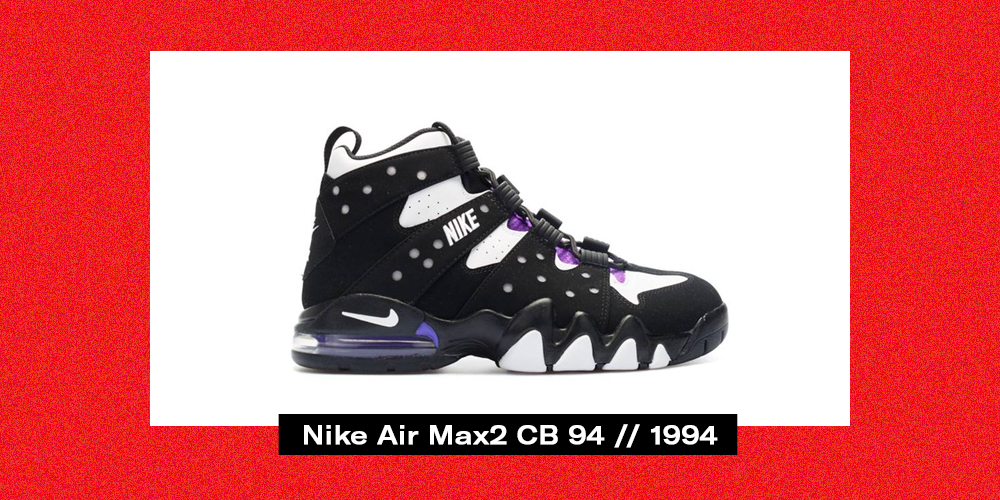
Could Charles Barkley carry a signature line?
After years of being the frontman for Force, 1993’s MVP honor and Michael Jordan’s sudden retirement would all mean that Sir Charles was going to have to put the weight of Nike Basketball on his back.
Headed into the 93-94 NBA Season, the Nike Air Force Max CB would carry Chuck’s initials for the first time after long leading the brand’s bulkier basketball shoes. Essentially adding straps to his prior push – the Fab 5 approved Nike Air Force Max – the trial run at signature status would forecast the formula later seen on Kyrie Irving’s HyperRev to namesake model transition.
While the Nike Air Force Max CB was a relatively safe facelift on a Force favorite, the Nike Air Max2 CB 94 was absolutely nuts — literally.
Inspired by a straight jacket, the model mirrored the wildman’s game that borders genius and insanity. Introducing an Air Max2 heel unit that could make any big boy feel like they could fly, the second signature shoe for Charles Barkley proved a bold brand statement in regard to innovation but totally owned the personality of its endorser.
“We wanted to capture Charles’ game and his personality,” Tinker Hatfield told Nike News. “The outlandishness of Charles’ persona and the beauty of the product married up.”
From a design language perspective, the contrast of rounded lines with aggressive overtones would mirror that of Barkley’s actual build and be carried out on following signatures.
Going all in on Chuck proved the right investment at the right time.
Reebok Kamikaze II // 1995

How good is the Reebok Kamikaze II?
When doing a mental search for the keywords ‘Kamikaze’ or ‘Shawn Kemp shoes’ the sophomore signature for The Reignman outranks them all.
Loud and electric just like Kemp, the Kamikaze II was a linear progression from its predecessor bringing even more boldness. Incredibly in line with Reebok’s headlining models from the same season, the stark contrast of dark nubuck and white leather was fundamentally the same as that of the Shaqnosis, Blast and Big Hurt.
The difference? Lightning lines played perfectly to The Reignman’s name and game. The brand had a hit and it still holds up.
The Kamikaze II is Kemp’s footwear legacy in a singular shoe. Later Kemp signatures would carry more tech and less continuity, registering as more innovative, but less memorable. One has to imagine just how much more noise Reebok would’ve made had they stuck to the script of his second silo.
Nike Air Penny 2 // 1996
Coming off the heels of a smash hit debut and preluding the most progressive basketball shoe of all time, it would’ve been easy for the Nike Air Penny 2 to get lost in the sauce.
To some, the second Penny may be the most symbolic of the star himself.
Riding high off the 1996 Summer Olympics in Atlanta, the 24-year-old Hardaway had a Gold Medal and pint-sized sidekick to his name. Entering the 96-97 season sans Shaq for the first time, Big Penny, Lil Penny and the Air Penny 2 would get airtime all season from classic commercials to the 1997 NBA All Star Game.
Aesthetically and functionally, the Nike Air Penny 2 is Penny Hardaway.
Smooth and fluid, the wavy lines of the Penny 2 played like the point guard himself, registering as equal parts calm and electric. A combination of heel Air Max and forefoot Zoom Air spoke to the 6 foot 7 star who could fly coast to coast and slam on big men.
Both the Penny 1 and Foamposite One prove more powerful than that of the Penny 2, the second signature from Hardaway is all his own.
Close comps in the Air Way Up and Foamposite Pro cause confusion with their Penny peers. Conversely, the fluid design direction of the Penny 2 would place it at the crest of Nike’s next wave of design, inspiring the Penny 3 and 4 to follow.
FILA Grant Hill II // 1996
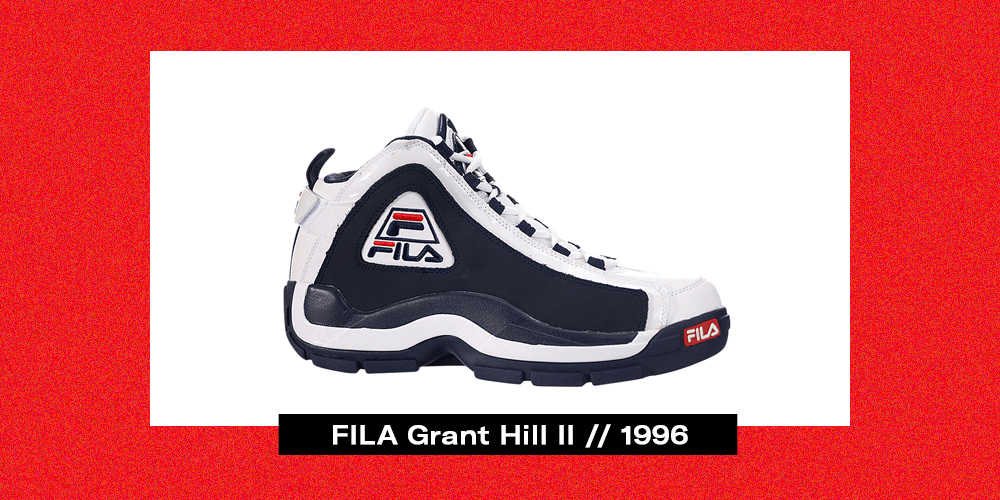
Imagine a player with more ceiling than Magic Johnson or Larry Bird and as much marketability as Michael Jordan.
That player was Grant Hill.
As safe as Steph, as gifted as LeBron, the Duke prodigy was perhaps the most sellable star the league had ever seen. Attempting international stardom from jump, Hill signed with Italian brand FILA for an estimated $30 Million upon entering the league.
Smart money, indeed.
As a rookie in Detroit, Hill would score his own signature, share Rookie of the Year honors with Jason Kidd and lead the entire league in NBA All-Star fan voting. The latter feat was a first for a rookie yet to be duplicated.
Yes, not even LeBron or Zion proved as popular upon arrival as Grant Hill was.
Following the success of Grant’s rookie run in the FILA Grant Hill, the FILA Grant Hill II smoothed out the aggressiveness of its predecessor for a shoe just as smooth as the man who wore it.
Once again, Hill would lead the league in All-Star votes, beating out a Concord 11 wearing Michael Jordan in the midst of a 72-10 season and movie star Shaquille O’Neal. The Pistons point forward would do it all in a shoe that featured HIS FULL NAME. That, as the kids say, is different.
Stuffed with star power and literal shine, patent leather trim took Hill’s second signature to new heights. The FILA Grant Hill II was worn famously by the late Tupac Shakur, serving as a gift from Hill himself. Appealing to all audiences, Hill would also wear the ‘96 silo as the face of the USA’s new Dream Team in Atlanta.
The FILA Grant Hill II would prove the apex of the promising prodigy’s sneaker line. Later models from FILA darted in design direction and an eventually injured Hill left the Italian brand.
No one else would ever outfit Hill with a signature, but in retirement the active analyst would return to FILA for retro campaigns, all led by his famous second silo.
Reebok Answer I // 1997

Allen Iverson took the NBA by storm and so did his first signature.
The Reebok Question, worn by Bubba Chuck in his Rookie of the Year debut, was an homage to the Air Jordan 11 favored by an ameatuer AI at Georgetown. Pulling from the patent leather phenom, the Question swerved in styling by carrying all of Reebok’s then-marquee technical attributes.
Plush leather, soft suede and Hexalite cushioning set the stage for the brand’s biggest shoe since the Workout.
Essentially, AI’s second silo had the tall order of following an all-time classic. The Reebok Answer 1 proved Iverson was the solution for his sponsor as the Bolton brand entered a new era.
Sleeker, faster and flashier than the Question, the Answer 1 left Hexalite cushioning and bulky blacktop designs in the dust. Introducing DMX cushioning to basketball in its most abundant execution, the Answer 1 saw the second year Sixer pushing the most expensive basketball shoe the brand had to offer that season.
The shiny suit styling of the Answer 1 would prove one-and-done for Reebok with speed and toughness soon taking over the direction of the line. However, signature shoe #2 for AI and Reebok foreshadowed much of what was to come. Iverson would be the brand’s breadwinner for the next decade with DMX donning the majority of his models.
Nike Air Pippen II // 1998
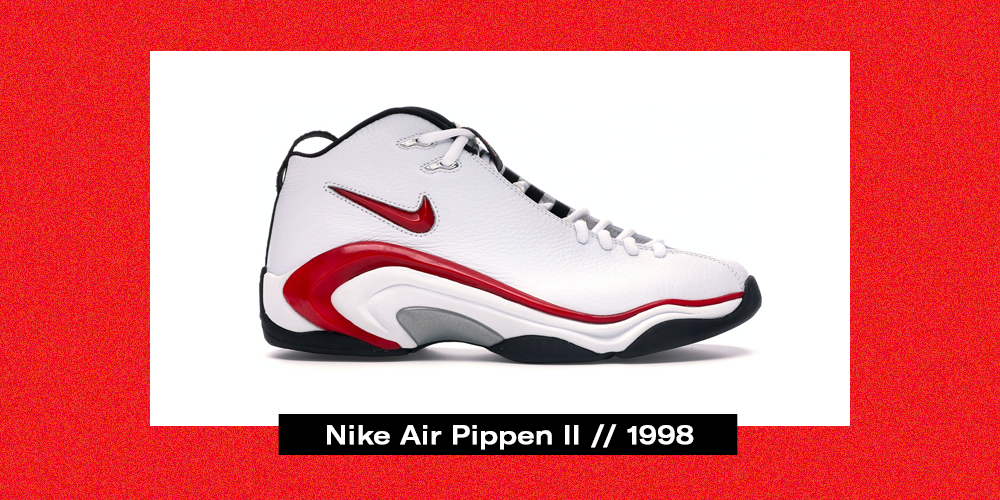
The second signature from Scottie Pippen saw something we rarely see early on in flagship footwear lines.
Reduction.
Historically, signature lines that play it safe go the route of linear progression, showcasing subtle upgrades over that of imagination. On the contrary, the disruptive route usually exemplifies wild creativity based on pouring into the athlete’s personality.
The funny thing? The Pippen II did pour into personality.
Seeing his second shoe at the tender age of 32, the All-Star wingman with a handful of rings was both sophisticated and accomplished. Simply put, Pip didn’t need a loud shoe to show how great he was.
Deep? Maybe. Dropping the flash of the Pippen 1 and refining the tech, the Pippen II was as effective and professional as Pip on the court. The Aaron Cooper design found unlikely inspiration from the 1951 Mercury. As timing would have it, Pip’s last ring would be won in the Pippen II, capping off a super successful six championship ride in Chicago.
The Pippen II was “Simplicity. Stripped down.” as Scoop Jackson would put it in Sole Provider. Such styling would prove the brief for Scottie’s next two signatures to come. Pippen would even go back to playing in his second sneaker years later in Portland in PE form.
Simple? Sure. Pippen? Perfectly.
adidas The Kobe II // 2001
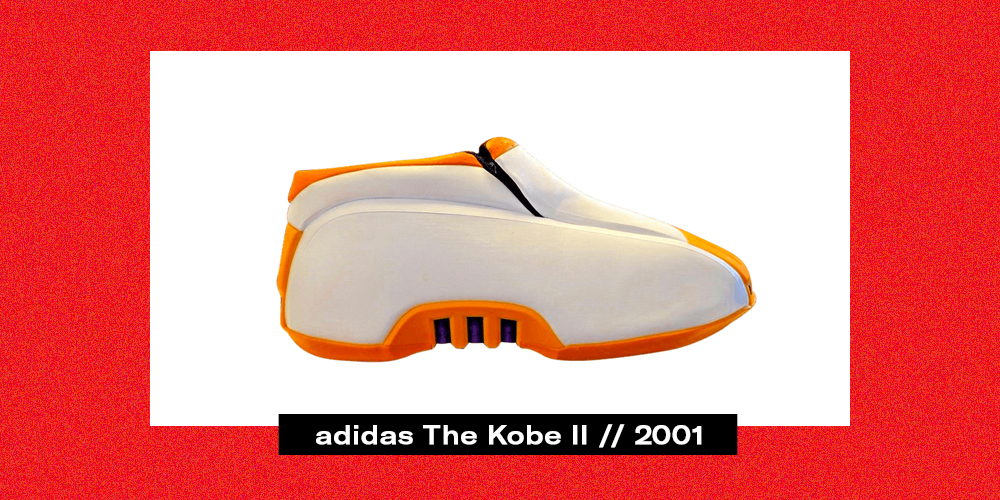
You know that new Drake and DJ Khaled song “POPSTAR” that just dropped?
That’s kind of the place Kobe Bryant was in at the early onset of the 2000s. A young chart topper where the NBA was concerned, Kobe was seen as sensational and safe, but it wasn’t all sweet.
Marketed as artsy, international and smart – which he was – Kobe’s image was presented as a stark contrast to that of Allen Iverson who owned the tough brashness every NBA player wanted to possess. While Kobe was everything adidas wanted him to be, they neglected one major component of who we’d soon know as the Black Mamba.
Kobe was a killer.
On his second run of signature styles from The Three Stripes, the adidas The Kobe II was something to marvel at and ponder in a museum. When it came to Kobe, it was not something to murder your opponent in. Bryant would prove this by going back to his previous signature in the NBA Finals and ending his adidas contract the summer after.
The Kobe II challenged traditional thought. It also challenged consumers. Truth be told, Bryant was already looking for an exit strategy from adi due to family financial drama and mismarketing in the young star’s eye.
The risky design direction of The Kobe II proved the last release of the partnership and lives in infamy ever since.
Nike Zoom LeBron II // 2004
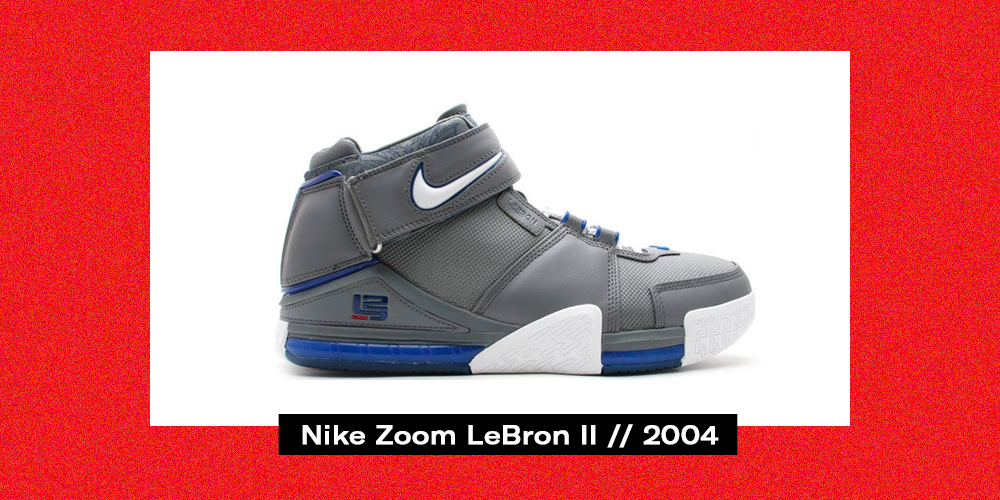
When King James was just a prince, Nike had already rolled out the red carpet to give him the throne.
As it turns out, the almost $100 million they put down on an 18-year old from Akron was a good bet.
After announcing his arrival and a change of the guard with the Nike Air Zoom Generation, LeBron’s sophomore season saw his All-Star ascent and famous first name finally on a shoe. The Nike Zoom LeBron II was not a linear upgrade from that of the AZG but almost an exponential explosion.
The AZG’s mesh and leather construction was rearticulated in powerful and padded fashion on the sequel. Just the same, forefoot and heel Air went from inline and encapsulated to that of the brand’s new Caged Zoom. Laser-etching offered the newest aesthetic innovation from that of Nike while removable ankle straps signified a leap from Flight to Force camp.
Throw in speed-lacing, Sphere lining and a Ken Link led traction pattern? The new direction of the LeBron line was here.
Appreciated at the time but perhaps underrated since, the Nike Zoom LeBron II redefined the footwear of King James. While the AZG was for everyone, the LeBron II proved that the Young King’s line was made to the exact specifications of a 6 foot 9, 250 lb prodigy.
The LeBron II proved that James was the new priority in Beaverton and that every signature to come would be stacked with the top tech the brand had to offer.
Nike Kyrie 2 // 2015
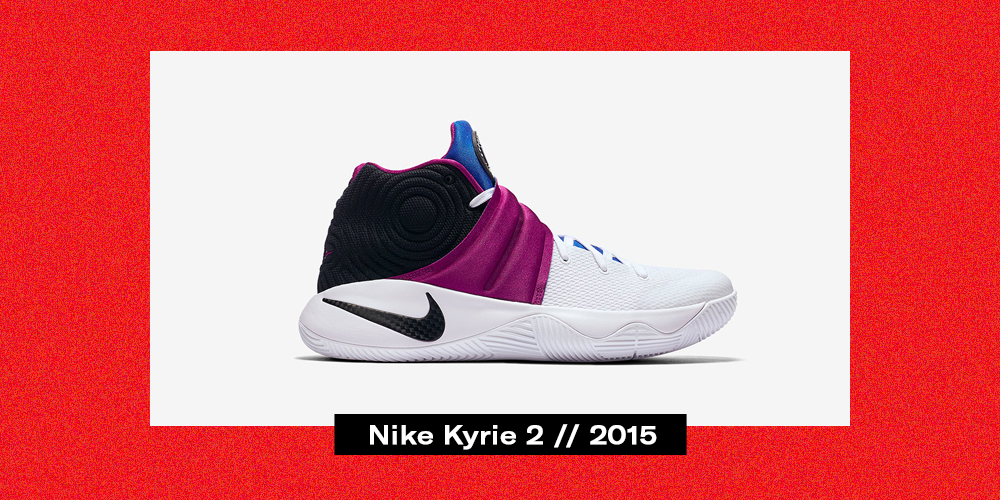
The Nike Kyrie 1 was a hit as most introductory signature sneakers are.
Catching Uncle Drew on the rise of his popularity and doing so at a price point less than his peers, the Kyrie 1 packed value and newness. More or less an extension of the HyperRev line Irving had already been playing in, Nike’s rerouting of said design direction by putting Kyrie’s name on the shoe was perfect timing even if it lacked Irving’s identity.
The Kyrie 2 though? That was the prodigy point guard personified.
Unorthodox in a manner that sways from smooth to herky jerky, the Kyrie 2 was unlike anything on the market at the time. The swooping strap and curved outsole made little sense to fundamentalists but played perfectly to the questioning thought of Irving.
Technically articulated by Leo Chang, the design language of the Kyrie 2 may seem like it was made to throw people off, but it was scientifically shaped to propel Irving’s unique game.
Many Kyrie models would rely on color stories to prove they were for the game’s most misunderstood point guard. The Kyrie 2 let you know exactly who the shoe was for through its design language, not its themes.
Not everyone understood the Kyrie 2, but no one could question the brilliance.
Under Armour Curry II // 2015
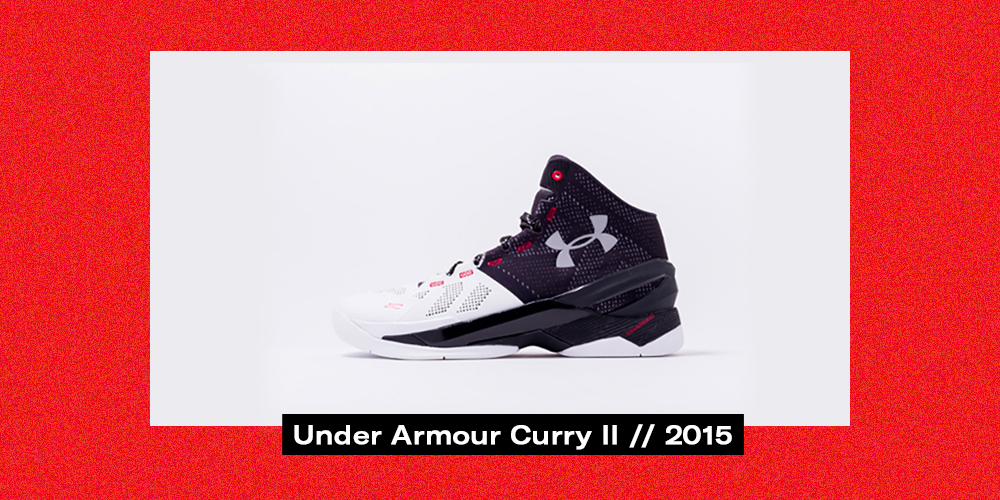
Just how big could Steph Curry get?
The Under Armour Curry II set the stage and the bar for exactly that. After famously leaving Nike and giving UA Basketball a face they could sell, the timing for the Baltimore brand and Davidson dandy couldn’t be better.
Coming off the smash hit success of Steph, the Warriors and the Curry I, the Curry II took the game-changer’s MVP resume and played to timely trends in footwear. Carrying over Charged cushioning and the unorthodox cut from the Curry 1, the Curry 2 was essentially a slightly sturdier take on his first shoe.
Less innovation, more imagination, the Curry 2 completely capitalized on collectible colorway cache and Steph’s stardom. For the first time ever, people were lining up for Under Armour shoes and even looking at them as an investment.
The Curry II saw Under Armour showing the self-restraint to make a shoe that kept Steph safe while still widening their lens to chase sneakerheads. Truth be told, UA got greedy or at least overreached with lifestyle plays and after-the-fact themes (remember the “Chef” Curry II Lows?)
Despite such debacles, Under Armour still hit a home run with the Curry II.
In years to follow, design language would zig and zag on models to come. To this day, the Curry II still proves the peak of Steph’s signature series thus far.
Nike Zoom Freak 2 // 2020

The ascent of Air Jordan, creativity of Kyrie and star power of Steph all play into the promise of the Nike Zoom Freak 2.
Like Mike, rearticulated cushioning and enhanced upper support prove the sequel story after a daring debut. Unlike Mike, we see a price-point plateau ($120 for inline, $130 for energy) that’s equal to that of the original despite an elevated profile.
Compared to Kyrie, both the Greek Freak and Uncle Drew’s celebrated second signatures are inspired by their flagship footwork. Crafted for Giannis’ unstoppable Euro-step, the Freak 2 moves Zoom Air to the forefoot and decouples the outsole, scientifically strengthening each strike while terrifying any defender.
Showing shades of Steph, Giannis’ second signature shoe coincides with coming off his first MVP award and his first shoe. Making the leap from fresh face to favorite, Giannis enters the bubble defending best in show hardware, back-to-back All-Star captain fan voting and the best record in the league.
Not only are there new shoes on his feet, there’s a target on his back.
Entering his second signature shoe, Giannis has gone from the hunter to the hunted like those before him. Every player on this list has redefined their position. Giannis on the other hand has redefined the idea of position.
Juxtaposing force with flight, aggression with charisma, the Nike Zoom Freak 2 personifies Giannis’ unicorn dominance. When looking at the sharp design and no frills unveiling, one thing is certain: Giannis is focused. Will Giannis win his first NBA title and second MVP award in the Freak 2? That remains to be seen, but the stage has been set.
Pushing the envelope without pushing the price, the Freak 2 is ready to write its own story. Start writing your own story as the Freak 2 available now at Finish Line in Mens ($120), Grade School ($100), and Little Kids ($75).
